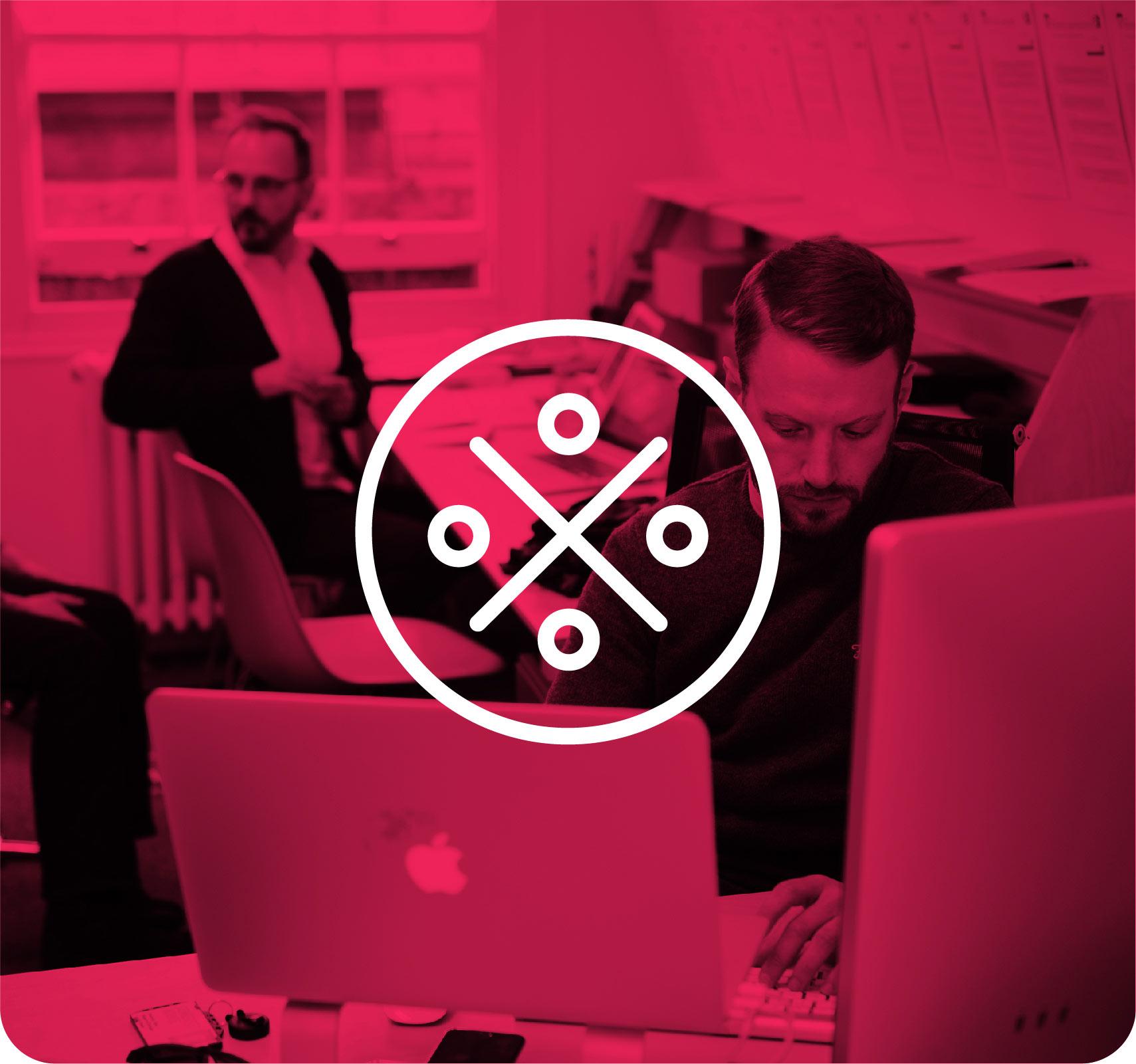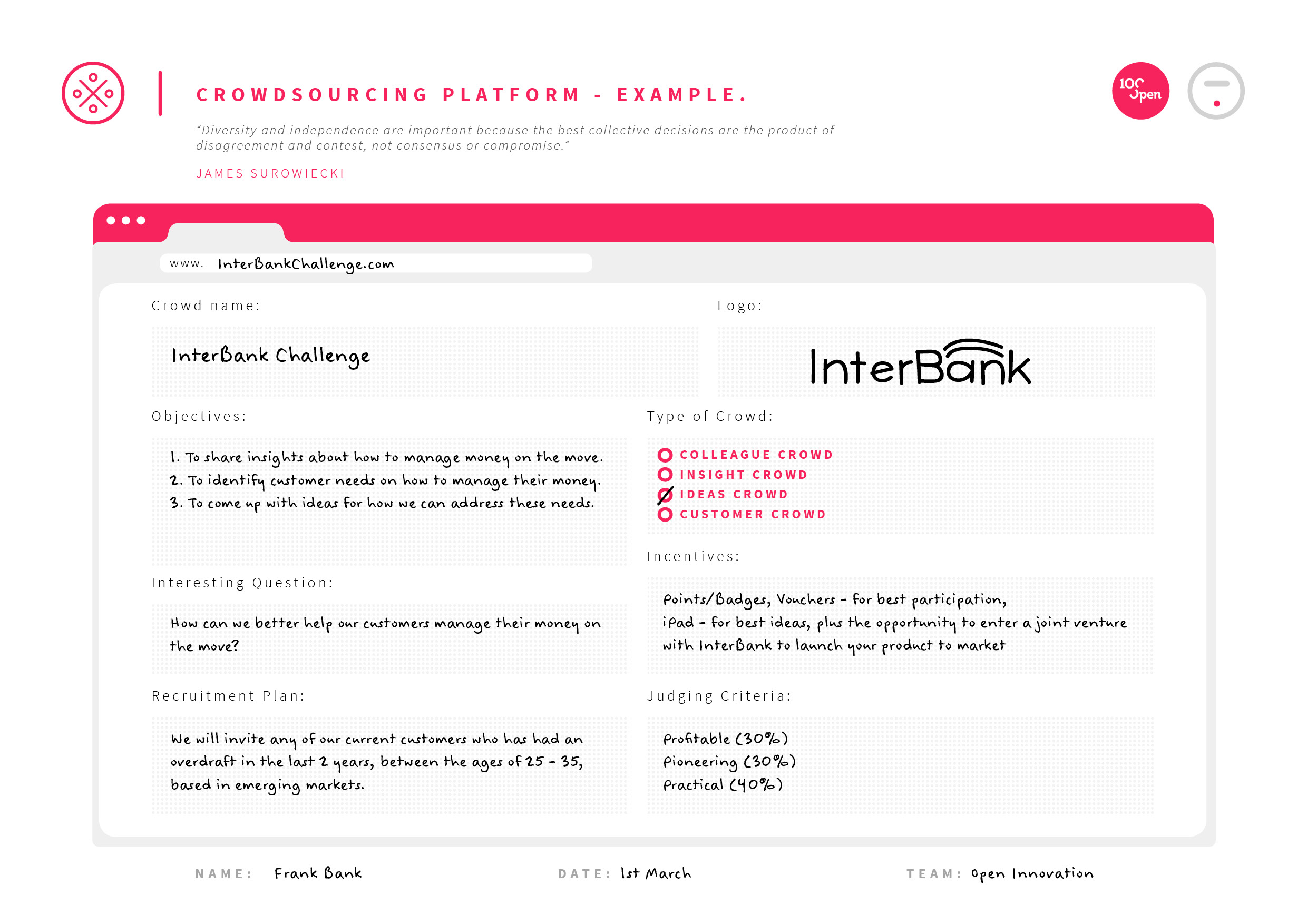This tool is to plan the use of an online crowdsourcing platform. Such platforms are used to host communities that respond to specific challenges by submitting insights, ideas or business propositions for new products and services. We use this template to design elements of our crowdsourcing platform and to visualise how our challenges will work in practice.


"Diversity and independence are important because the best collective decisions are the product of disagreement and contest, not consensus or compromise."
James Surowiecki
First we hire a crowdsourcing platform; there are many proven and cost-effective products available. Here is a checklist to help decide which one to choose:
Will we get help with the design of the challenge process?
Are we paying by the month, the challenge or the size of the crowd?
Whose responsibility is it to recruit the crowd? Is it intuitive and quick to configure?
How easy does it make the facilitator’s jobs of communicating and analysing?
Is it easy to upload and display photos, videos and links?
Who will design the site’s look and feel?
How good are communications from the site to members? (e.g. weekly emails, blog or some other media?)
How easy is the sign-up process? Is there a choice between invite-only and open access? Can people join using their social media accounts?
Are the site statistics easily accessible and downloadable? Are there useful terms and conditions that deal with community behaviour, intellectual property, etc?
Can platform facilitators and members upload photos of themselves and short biographies?
Next we sit down to design the key features of our platform. Print off the template and address these questions with colleagues or your crowdsourcing provider.
1. What is the name of our crowd? Having the right tone for our crowdsourcing platform can help recruit and engage people. Make it descriptive and light-hearted. Will the platform have a separate identity and logo or keep close to our design guidelines?
2. Record the project objective: Be specific and realistic. What type of innovations are you seeking and why?
3. Choose the type of crowd: Insight Crowds help us get to know what our consumers think in depth and over an extended period. Running an Insight Crowd is like having the depth of a focus group but with the scale and longevity of a research panel. Ideas Crowds are used to brainstorm ideas for new products and services. They are often formed from customers or users. In later stages of the innovation process Ideas Crowds can be used to prototype or pre-test new concepts in a process that 100%Open calls customer-co-creation. Colleague Crowds are formed from within our company. They are often used to build an agreed strategy, discover best practice, engage staff around a particular challenge or to connect up company silos and release hidden internal value. Discovery Crowds are business-to-business competitions to find and select new technologies or services to commercialise and scale. Such crowds are less collaborative and are often used to privately submit propositions and therefore need a different design of platform.
4. The Interesting Question: Effective challenges start with an Interesting Question that becomes the headline for our challenge on the platform (See the Interesting Question tool). It needs to be interesting to the crowd to motivate enthusiastic participation, and interesting to our company so that it follows through.
5. Design the site structure: Annotate the tabs at the top of the tool to show what information is going to be useful for community members on other pages. It is tempting to write everything we know about the project but it is more effective to edit the information. The more time members spend reading the background the less time they will spend contributing.
6. Set the incentives and judging criteria: A combination of both? It is important to be transparent with the community about the process and their incentives for participation. Incentives can be intrinsic (taking part, helping a cause) or extrinsic (cash, vouchers, investment or business incubation). Decide in advance the process for choosing the best ideas. Will the crowd decide or will we form a judging panel? See Challenge Designer for a number of suggested ways to recruit and incentivise.
7. Recruit the crowd: This is a key part of the process and much will depend on how successful we are at recruiting a crowd that knows about the subject but is also diverse (see Network Builder). How will you recruit – using emails, targeted adverts or via a recruitment agency? Will the crowd be open or closed? Can members sign up using social media or their work intranet? There is no maximum size but above 2000 members can be hard to facilitate. Bear in mind the 90:9:1 rule of online communities: For every 100 participants there will be on average 1 active contributor, 9 who will respond and 90 ‘lurkers’. Most crowdsourcing communities do better than this, but we shouldn’t expect everyone to participate all the time.
HOW THIS TOOL FITS IN WITH OTHERS
See Challenge Designer to design the content and process for a successful open innovation challenge in more detail.
Check out the Interesting Question tool for how to create crowdsourcing challenges that are based around clear, compelling and communicable questions.
See Network Builder for how to design relevant and bespoke networks that support successful open innovation.
Read the Facilitation Guide for how to keep our crowd happy and productive.

Classmates of mine are conducting an innovation project for a financial management company seeking to ideate a product/service to offer greater social purpose/meaning in the lives of their clients. Please assist in completing this poll)
Legacy as we are defining it is the positive impact one leaves on the world (present and future). In which area do you wish to leave a legacy?
a. Impactful investing
b. Personal branding
c. Funding and engaging in disruptive innovation / Start-ups and Innovation Competitions
d. Community Service (the action of doing)
e. Charitable Donations
f. Relationships (family values, peer-to-peer